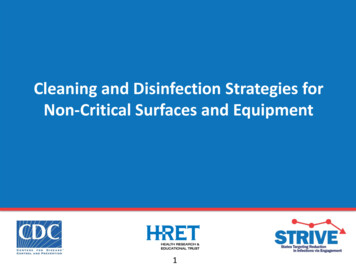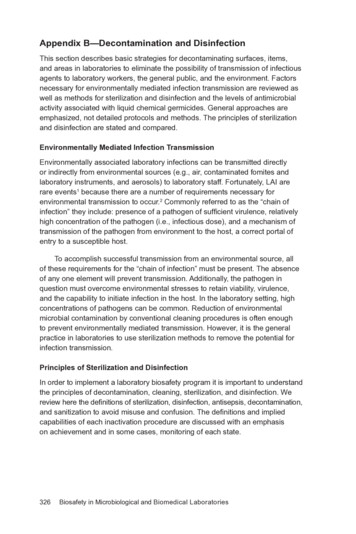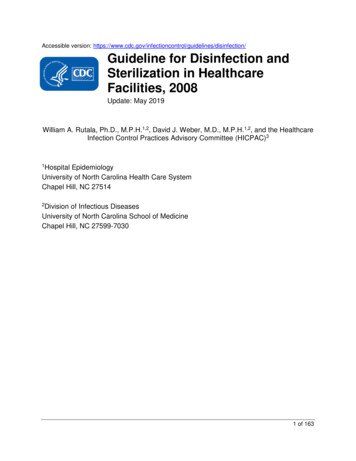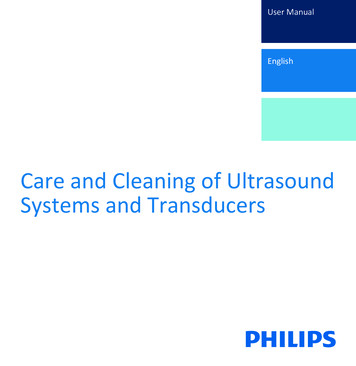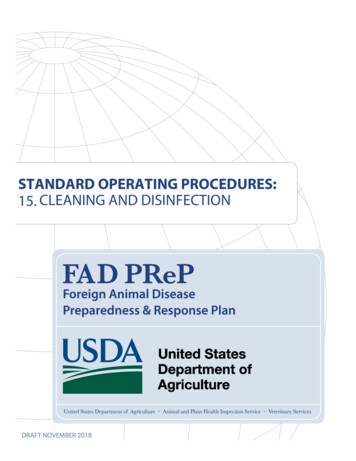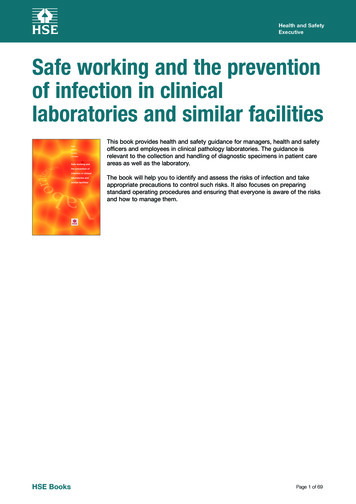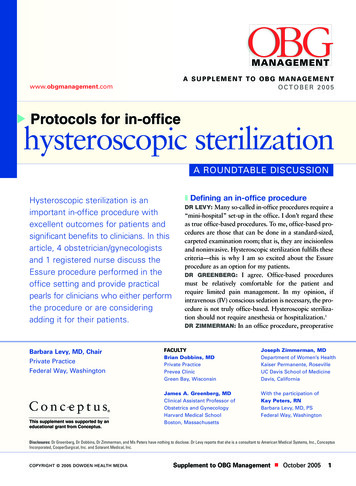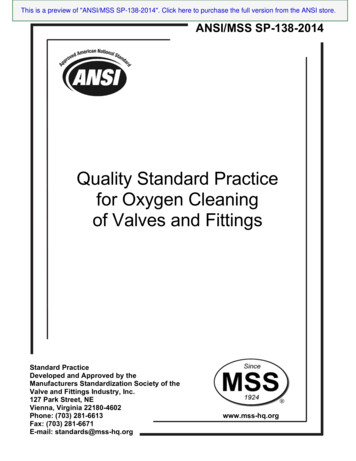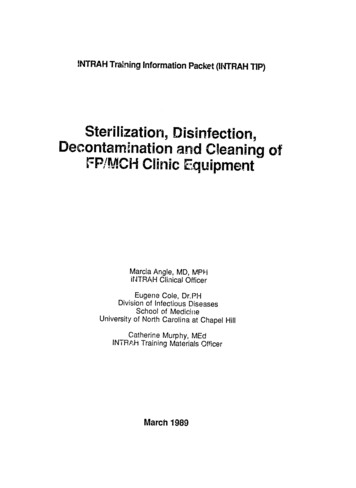
Transcription
INTRAH Trainina Information Packet (INTRAH TIP)Sterilization, Disinfection,Decontamination and Cleaning ofFP/MCH Clinic EquipmentMarcia Angle, MD, MPHiNTRAH Clinical OfficerEugene Cole, Dr.PHDivision of Infectious DiseasesSchool of MedicineUniversity of North Carolina at Chapel HillCatherine Murphy, MEdINTRAH Training Materials OfficerMarch 1989
training information packetMarch 1989Dear Colleague:Trainers, managers and service providers of family planning (FP) andmaternal child health (MCH) clinical services are increasingly concerned aboutpreventing the acquired immune deficiency syndrome (AIDS). In addition tocommunity education and distrioution of condoms, AIDS prevention shouldinclude avoiding accidental transmission of AIDS by contaminated needles orother equipment.Many disease-causing microorganisms besides AIDS can be spread bycontaminated equipment. This INTRAH TIP outlines the cleanig, sterilization,disinfection, and decontamination procedures necessary to prevent accidentaldisease transmission in FP/MCH clinics, based on supplies available in Africaand Asia.We hope this INTRAH TIP will be a useful reference for you and yourcolleagues. Comments or suggestions on this NTRAH TIP will be received withappreciation. Single copies of this TIP, or any INTRAH TIP, can be obtained bywriting:Ms. Catherine MurphyTrainkng/Materials OfficerProgram for International Training in HealthSchool of MedicineUniversity of North Carolina at Chapel HillCampus Box 6100, 208 North Columbia StreetChapel Hill, NC 27514. USAwaiLcharITapL2 TCIo 8., -2o(i. l The idea for thiswaflchairt wa, or,trn1jted oy Stembile,la ta3tLM,., /ilr- ! .piO Centre in
INTRAH Training Information Packet (INTRAH TIP)Sterilization, Disinfection,Decontamination and Cleaning ofFP/MCH Clinic EquipmentMarcia Angle, MD, MPHINTRAH Clinical OfficerEugene Cole, Dr.PHDivision of Infectious DiseasesSchool of MedicineUniversity of North Carolina at Chapel HillCatherine Murphy, MEdINTRAH Training Materials OffierMarch 1989
INTENDED AUDIENCES* Trainers of clinical family planning/maternal-child health (FP/MCH) personnel,* FP/MCH clinic managers, andOther professional FP/MCH clinic staff.TABLE OF CONTENTSPageAcknowlegementsIntrod u c tio n .11. What procedures kill disease-causing microorganisms .12. When to use what procedure .23. Why cleaning objects is important .34 . How to sterilize ." steam steriliLation . dry heat sterilization .* sterilization by boiling ." cold ste rilization. 5.56. 7. 85. How to do high-level disinfection .11* chlorine-releasing solutions .11" iodofor solutions . . 14* alc o ho ls . .15" other solutions. . 166. How to decontaminate .177. When to use antiseptics, and when not to .188. Which method to choose for different types of equipment . 209. Sterile gloves: when and how to use.22Referen ces.25Pull-Out Wallchart
ACKNOWLEGEMENTSThis INTRAH Training Information Packet (INTRAH TIP) was reviewed by a number ofprofessionals who train family planning service providers cr who themselves providefamily planning services in Africa or Asia. The authors gratefully acknowledge theirvaluable contributions.Grace Mtawali, Regional Training Officer, INTRAH Office for East ani Southern Africa, Nairobi, Kenya.Djaritou Thiam, Regional Training Officer, INTRAH Office for West and Central Africa, Abidjan, C6ted'lvoire.The staff of the Integrated Maternal Child Care Services and Development, Inc. (IMCCSDI), Quezon City,The Philippines.Siembile Matatu, Tutor, Zimbabwe National Family Planning Council, Harare, Zimbabwe.Wendy A Cronin, Blue Ridge AIDS Coordinator, Charlottesville, Virginia, USA.Mary Ellen Stanton, Consultant, Midwifery and family planning training, Lcxington, Virginia, USA.Linda Tietjen, Consultant, Infection control training, Baltimore, Maryland, USA.Lynn Knauff, Deputy Director, INTRAH, The University of North Carolina at Chapel Hill, North Carolina,USA.Gabrielle Beasley, Training Materials Specialist, INTRAH, The University of North Carolina at Chapel Hill,North Carolina, USA.We are also grateful to Ms. Susan Eudy for wordprocessing and revising the manuscript and to Dr. JamesLea, INTRAH Director, for his support and valuable suggestions.Developed under USAID Contract #AID/DPE-3031-C-00-4077. The views expressed in this documentare the responsibility of INTRAH and do not represent the policy of the U.S. Agency for liliernationalDevelopment.
INTRODUCTIONIn recent years, service providers in family planning (FP) and maternal child health (MCH)clinics have become more concerned about preventing the acquired immune deficiencysyndrome (AIDS). AIDS prevention in the FP/MCH clinic includes education of the public,distribution of condoms, and proper processing of clinic equipment.Many disease-causing microorganisms besides AIDS can be spread by contaminatedneedles, syringes and other clinic equipment. This INTRAH TIP will serve as a reference fortrainers, clinic managers and service providers who wan to minimize the risk of spreadingdisease from contaminated FP/MCH clinic equipment.1. WHAT PROCEDURES KILL MICROORGANISMS, INCLUDING THE HUMANIMMUNODEFICIENCY VIRUS (HIV) Microorganisms are microscopic plants or animals. Disease-causing microorganismsinclude fungi, parasites, viruses, bacteria and bacterial endospores. F ,-, eria, parasites, fungiand viruses, including human immunodeficiency virus (HIV, the virus which causes AIDS) willbe killed by carefully following the sterilization and disinfection procedures listed in thisINTRAH TIP.The human immunodeficiency virus (HIV) can be transmitted through the use of needles,syringes and other invasive equipment contaminated with blood of an infected person.Vaginal and cervical secretions and semen have also been shown to transmit HIV. Becauseall body fluids may contain blood or white blood cells, all medical instruments for invasiveprocedures (including needles and syringes) should be cleaned after each use, thensterilized or given high-level disinfection to prevent transmission of HIV (WHO, June, 1988).HIV is a fragile (lipophilic) virus. HIV is very sensitive to chlorine solutions (bleach) and israpidly killed on exposure, making bleach an ideal decontamination agent, especially forlarge surface areas. (Concentrations and preparation of chlorine solutions are discussed insection 5). HIV is also rapidly klled by high heat.If medical equipment, linens or clothing has Lag amount of blood or other body fluids, thenpre-soaking in a 0.5% (5000 ppm 5 grams/liter) bleach solution will kill HIV, making thearticle safe to touch during cleaning. For cleaning medical instruments, gloves should beworn; see section 3.HIV is nrnt transmitted by routine household objects. Routine washing in warm, soapy waterof dishes, glasses, and utensils is sufficient. Routine laundry of linens is also sufficient.INTRAH TIP:Sterilization1March 1989
2. WHEN TO USE WHAT PROCEDUREThe terms "decontamination," "disinfection" and "sterilization" are often confused. Not allobjects require the same procedure; the table below shows the procedure needed fordifferent objects, depending on the extent of contact they have with tissue and skin.How to Decide What Procedure to Use:Sterilization, High-Level Disinfection, or DecontaminationHuman tissuesthe instrument/object will touchExamples ation,high-level disinfection, ordecontamination)all tissue beneath skininvasive instrumentssuch as needles, andsyringes, scalpels, trocharsfor Norplant sterilization, todestroy all live micro organisms includingbacterial endospores"mucus membranesor broken skinuterine sounds,specula, IUDs,gloves for pelvic examhigh-level disinfection,to destroy all live micro organisms exceptbacterial endospores*intact (unbroken)Lkinpelvic exam tabletop or other surfacescontaminated by body fluidsdecontamination,to destroy easilykilled viruses (such as HIV),and other fungi, parasites andbacteriabacterial endospores are forms of bacteria which are very difficult to kil! due to their casing or coating; types ofbacteria which can make endospores include the bacteria Clostridia, which causes tetanus and gangrene.Bacterial endospores can OnI be reliably killed by sterilization.INTRAH TIP:Sterilization2March 1989
3. WHY CLEANING OBJECTS BEFORE STERILIZAT'ON, DISINFECTION ORDECONTAMINATION IS IMPORTANT"Cleaning" is the removal of foreign matter (e.g., soil, rust, feces, food) from objects, usingwater and detergents. Proper cleaning of objects before sterilization, disinfection ordecontamination is very important: When objects are not first adequately cleaned,procedures to sterilize, disinfect or decontaminate will fail.If organic materials are not adequately removed before soaking in some disinfectants (e.g.,alcohol and iodine), the disinfectant will be partially inactivated and become less effectiye.When a layer of foreign matter is covering an instrument, the disinfectant or decontaminantmay not be Pble to reach the instrument underneath, allowing microorganisms to remain.NOTE: Gloves must be worn while cleaning instruments, This pair of gloves should bediscarded (or left at the end of the day for cleaning the following day). In addition towearing gloves, extreme care must be taken to prevent needle sticks and/or cuts.HOW TO CLEAN METAL INSTRUMENTS BEFORE STERILIZATION ORDISINFECTION1. After use, rinse instruments in cold water to remove any blood.NOTE: If instruments are contaminated with large amounts of body fluids and if HIV orHepatitis B virus (HBV) is prevalent in the area, add bleach to make a .5% solution of thefirst rinse water, and soak the instruments for ten minutes. This will kill HIV and HBV, andprotect personnel during the process of cleaning (WHO, June 1988, and Wenzel, 1987).2. Next, scrub instruments with a brush in hot soapy water (be sure to clean the teeth, jointsand screws).3. Rinse again in cold, clean water until no soap remains (soap can interfere withdisinfection).4. Proceed with sterilization (see section 4) or high-level disinfection (see section 5).HOW TO CLEAN GLOVES. INSERTERS, PLINGERS AND OTHER RUBBEREQUIPMEN!T BEFORE STERILIZATION OR HIGH-LEVEL DISINFECTION1. Rinse by soaking in cold water (for equipment soiled with blood, cervical secretions orsemen, it is best to soak for ten minutes with bleach added to make an 0.5% solution, inorder to kill HIV, before handling, even though gloves are used).2. Wash in lukewarm, soapy water.3. Rinse in clean, cold water until no soap remains (soap can interfere with disinfection).4. Proceed with sterilization (see section 4) or high-level disinfection (see section 5).INTRAH TIP:Sterilization3March 1989
HOW TO CLEAN NEEDLES AND SYRINGES BEFORE STERILIZATION1. Leave needle attached to syringe.2. Fill syringe with high-level disinfectant solution (by drawing up through needle). (Seesection 5).3. Cover syringe and attached needle with disinfectant solution (by laying them horizontallyin flat tray), and leave immersed in disinfectant solution for 30 minutes.4. Expel disinfectant solution from syringe and needle.5. Rinse syringe and needle in boiled water (see section 4 for boiling times) by filling andexpelling water at least twice (fill and expel through needle).6. Detach needle from syringe and make sure hub area is clean.7. Examine needle and syringe for bent needle tips or other damage, syringe seal condition(rubber ring), needle hub fit to syringe, readable syringe markings, etc. Dispose ofdamaged needles and syringes in a special container for sharp objects (when full, thecontainer must be burned or buried).8. After the cleaning discribed above, it is critical that the syringe and needle beSTERILIZED prior to reuse (see section 4).CHOOSING DISPOSABLE VERSUS RE-USABLE NEEDLES AND SYRINGES" When available and affordable, disposable, single-use syringes and needles aregenerally preferred for all client care and laboratory procedures." Do not choose disposable syringes and needles if it is likely they will be re-used withoutproper sterilization." If, for economic and practical reasons, it is likely syringes and needles will be re-used,choose one piece needle-syringe units or needle-locking syringes. These units makecleaning the needle easier, because the syringe can be used to draw up and expel thedisinfecting solution through the needle as described above.CAUTIONS ON RE-USABLE NEEDLES AND SYRINGES" When needles and syringes are to be re-used, it is imperative that both be cleanedbefore sterilization and re-use." Where needles (disposable or re-usable) are to be re-used, it is important that both becleaned then sterilized BEFORE EVERY NEW USE.CAUTION ON DISPOSABLE NEEDLES AND SYRINGES* When disposable syringes and needles are discarded after use, care must be taken toavoid their re-use or accidental contamination of workers during refuse removal.Dispose of used needles and syringes in special container for sharp objects; when fullthis container must be burned or buried.Adapted from: WHO: Guidelines for Freventionand Control of Infection with LAV/HTLVIII. Geneva, monograph WHO/CDS/AIDS/86-1, May1986 and WHO: Injectable Contraceplves - Sterilization Alert, cted in UNFPA - PIACT: Product Information Memo 1988; 10(3):5-6.INTRAH TIP:Sterilization4March 1989
4. HOW TO STERILIZEDefinition: "Sterilization" is the complete elimination of all live microorganisms (viruses,fungi, parasites and bacteria), in.luding bacterial endospores. Those objects which will entera patient's bloodstream or penetrate a patient's tissues, such as needles, syringes,Norplant insertion trochars, and scalpels, must be sterile. Methods of sterilization includeautoclaving, using dry heat, boiling and "cold sterilization" (by overnight soaking in a "highlevel disinfectant"); these methods are described below.Storage: Sterile equipment will not remain sterile unless properly stored. Sterileequipment should be either carefully packaged in a sterile wrapping, or stored in a sterilecontainer with a tight-fitting lid. Where alcohol is available, store all unwrapped sterilizedequipment submerged in 70% alcohol, in a sterilized container. Change the alcohol weeklywhen the container is resterilized. Where alcohol is not available, dry storage in a sterile orhigh-level-disinfected covered container is best. Avoid using antiseptics for storage, sincePseudomonas and other common bacteria have been shown to grow in Hibitane , Savlon ,Zephiran0 and other antiseptics. (Block, 1983: p. 402, 409). (For a list of common antiseptics,see section 7).Water: A supply of sterile water will be needed for sterilization. Prepare a new supply ofsterile water in a sterile, covered container every day either by boiling (see section 6 torinstructions on how long to boil) or by adding chlorine to make a .5% solution (see section 5for dilution instructions). It is best to filter the water before boiling or chlorinating, if the wateris contaminated with microorganisms. Once the water has been made sterile, be careful notto dip unsterile objects into it. Note: Chlorinated water should not be used to diluteformaldehyde or compounds containing ammonia (including centrimonium/centrimidecompounds). Chlorinated water is not ideal as a final rinse for sterilized metal items, aschlorine does corrode metal; boiled water is preferable.STEAM STERILIZATION BY AUTOCLAVING OR USING A PRESSURE COOKER:THE PREFERRED METHODInstructions:1. Pre-clean all instruments to be sterilized.2. All instruments (scissors, hemostats, etc.) should be open during steam sterilization. Tohelp prevent dulling of sharp points and cutting edges, wrap the sharp edges and needlepoints in gauze before sterilizing.3. If using autoclave, it is best to wrap clean inst,'uments or other clean objects in cottoncloth, a double thickness muslin, paper wrapper or newsprint. (Unwrapped instrumentsare only sterile if used immediately after removal from autoclave, unless keot in acovered, sterile container).4. If using a pressure cooker or kerosene powered autoclave, bring water to boil until steamescapes from pressure valve only; turn down heat just enough to keep steam coming outof pressure valve. Do not allow to boil dry; steam should always be escaping frompressure valve.5. Sterilize for 30 minutes for wrapped objects, 20 minutes for unwrapped obiects; time withthe clock. The temperature should be 121 C (250 F); the pressure should be 15 poundsper square inch (15 lbs/in 2 )or 101 kPa (1 atmosphere above atmospheric pressure).INTRAH TIP:SterIlization5March 1989
6. After the 30 minutes have elapsed, slightly open lid to allow steam to escape. Allowinstrument packs to dry .mletely before removal (damp wrap around instruments candraw in bacteria, viruses and fungi from the environment).7. Ideally, a steam sterilizer log should be kept, noting time heat begun, time boilingachieved and heat turned down, time heat turned off, and time instruments removed. Alog can help ensure the required amount of time will be observed, even when multiple,new or hurried workers are responsible for overseeing the sterilization.8. Remove objects with previously sterilized large forceps/pickups. Objects wrapped insterile clot: or paper are considered sterile for one week. Unwrapped objects must beplaced immediately in a sterile covered container.NOTE: If using a pressure cooker, steam should escape from tho pressure valve, not fromeither the safety valve or from under the edge of the lid. If steam escapes from the safety valve instead of the pressure valve, the pressurevalve must be cleaned and inspected. If steam escapes from under the lid, the gasket (rubber circle) must be cleaned anddried or replaced. If steam escapes from safety valve or under lid, the autoclave or pressure cooker isnot working correctly, and is merely a boiling pot: to sterilize, you will need to referto the boiling times as listed below.Advantages:* Inactivates all microorganisms (bacteria, fungi, parasites and viruses), including HIV(virus causing AIDS).* Inactivates all bacterial endospores, including those causing tetanus and gangrene. Where there is no electricity, kerosene-powered steam autoclaves can be used.Disadvantages: Requires source of heat (fire, kerosene or electricity).* Requires autoclave or pressure cooker, which must be maintained in working condition.STERILIZATION BY DRY HEAT (Adapted from: WHO, June, 1988)Instructions:1. Pre-clean all instruments to be sterilized.2. Use only for instruments that can withstand a temperature of 1700C (340 0 F) (see chart,section 8: Which method for which instrument).3. Preheat oven to 1700 C (340 0 F).4. Put pre-cleaned instruments into oven and continue at 1700C (340 0 F) for 2 hours.5. Remove items after cooling with sterile forceps/pickups, and store in sterile wrap orcontainer.Advantages:* An ordinary electric household oven is satisfactory for dry heat sterilization.* HIV is very sensitive to heat.* Very good in humid climates.Disadvantages:* Requires oven and electricity or other fuel source. Cannot use for plastic syringes or rubber items (steam sterilization preferred for these).INTRAH TIP:Sterilization6March1989
STERILIZATION BY BOILING IN ALKALINIZED WATERWhere There Is No Autoclave: Will Boiling Sterilize?Sterilization means the elimination of all forms of microbial life, including bacterial spores. Ittakes 10-12 hours of vigorous boiling to kill resistant bacterial spores. Thus, WHO does notrecommend boiling when sterilization (elimination of bacterial endospores) is needed.Fortunately, simple alkalinization (removing acidity) of the boiling water will enable boilingwater to kill all endospores in 20 minutes at sea level. Alkalinization raises the boiling point,makes endospores more susceptible to boiling, and also helps prevent rusting of metalinstruments. However, a deposit of the alkali will be left on the instruments; thus boiling inalkali is not advised for needles or syringes.How to Alkalinize (remove acidity from) Water for Sterilization by BoilingSodium carbonate is a simple alkali which can be used. Add sufficient alkali by weight toequal the correct percentage of water by weight (assume 1 liter of water weighs 1 kilo). Thiswill render the water very alkaline to a pH of 11-12 after the water is boiled (Perkins, 1969).Caution: DO NOT BREATHE VAPORS OF BOILING ALKALINIZED WATER! DO NOTDRINK BOILED ALKALINIZED WATER! AVOID SKIN AND EYE CONTACT!Sodium carbonate (sal soda) makes a 2% (2 parts in 100) solution by adding 20 grams (15cubic centimeters) of crystal to one liter of water.Note: sodium bicarbonate will not sufficiently alkalinize water to the desired pH of 11-12 (Cole, 1988).How Long to BoilThe highest temperature that boiling water will reach is 100QC (212QF) at sea level. At higheraltitudes, water will boil at a lower temperature, thus longer boiling times are needed tosterilize. After reaching the boiling point, continue boiling FOR 20 MINUTES with the lid inplace; 20 minutes boiling time is sufficient at sea level to kill nearly all organisms in the water.As ihe altitude increases so must the boiling time: ADD 5 MINUTES FOR EACH 1000 FEET,or 300 METERS, ABOVE SEA LEVEL (Perkins, 1969, p. 315).Instructions:1. Pre-clean all instruments to be sterilized. (NOTE: Do NQ use this method for needlesor syringes).2. Add 20 grams (15 cubic centimeters) of sodium carbonate to each liter of water.3. Completely submerge pre-cleaned objects in the alkalinized water.4. Close lid over pan and bring water to a rapid boil.5. Start timer or note time on clock and record time boiling began on sterilization log.6. Boil for 20 minutes plus 5 minutes for each 1000 feet (300 meters) above sea level.7. Remove objects with previously sterilized large forceps/pick-ups.8. Rinse in boiled water to remove residue of sodium carbonate.9. Place objects in dry sterile container.Advantages:* Inactivates all bacteria, fungi, parasites and viruses, including HIV (virus causing AIDS).* Heat source, clean water, and pan with cover are commonly available.INTRAH TIP:Sterilization7March1989
Disadvantages:" Boiling alone is NQT reliable in killing bacterial endospores unless water is alkalinized. Alkalinized water (pH 11-12) is irritating to skin and respiratory tract, and is caustic(burning) to gastrointestinal tract if ingested, or to eyes if exposed.WHERE THERE IS NO AUTOCLAVE. DRY HEAT OR BOILING EQUIPMENT:" OL.D STERILIZATION" BY SOAKING IN HIGH-LEVEL DISINFECTANTSPL'UTIQNSWhen steam sterilization, dry heat sterilization, or boiling in alkaline water is not possible,objects which will touch sterile tissues require sterilization by available "high-leveldisinfectants." "High-level disinfectants" are those chemicals which can kill all live virus,bacteria, and fungi, except bacterial endospores (forms of bacteria which are very difficult tokill due to their coating). Some "high-level disinfectants" WILL kill endospores afterprolonged (overnight) exposure. High-level disinfectants which can be used for sterilizationinclude glutaraldehyde, formaldehyde and hydrogen peroxide. WHO does not recommendhigh-leve; chemical disinfectants for the sterilization of needles or syringes.iNOTE: The following should never be used for sterilization, due to their inability to killbacterial endospores and some bacteria:" Zephiran (benzylchonium chloride), Hibitane (chlorhexidine gluconate), Lysol (cresol with soap),* profiavine and acriflavine (acridine derivatives), Eusol (chlorinated lime and boric acid) C tavor, - (centrimonium with ethyl alcohol)," mecuiy Ik'urel, or other mercury compounds,* Savlon (centrimede and chlorhexidene), or other skin antisepticsAlthough carbolization (rinsing item with alcohol and then igniting with match) isoften used, data suggests this is an ineffective means of sterilization, and is notrecommended for sterilization.2% Glutaraldehyde (Glutaral or Dialdehyde) Solution or 8% Formaldehyde (as20% Formol or Formalin) for SterilizationInstructions:1. Pre-clean all instruments to be sterilized.2. For glutaraldehyde:* Aqueous solutions of glutaraldehyde must first be buffered (alkalinized) to a pH of 7.5to 8.5, to act as a "high-level disinfectant." Activate a new glutaraldehyde (glutaral)solution by adding the powder or liquid supplied with the solution; this renders thesolution alkaline (WHO, June, 1988). Inthis alkaline state, glutaraldehyde is stable for only 2 weeks after opening. Then thesolution must be replaced. Discard the solution sooner if it becomes turbid (cloudy).0 2% GLUTARALDEHUDE SHOULD NOT BE DILUTED.INTRAH TIP:Sterilization3March 1989
3. For formaldehyde:" A commercially available solution of formaldehyde (which will contain 35-40%formaldehyde) must be diluted with boiled water 1:5 (final solution containis about 8%formaldehyde).* DO NOT DILUTE WITH CHLORINATED WATER.4. Cover clean instruments and other clean objects completely with the solution ofglutaraldehyde or formaldehyde.5. Allow to soak st least 10 hours in glutaraldehyde, and at least 24 hours in formaldehyde.6. Remove objects from solution with sterile large forceps/pickups, rinse in sterile water, airdry, and wrap in sterile paper or cloth without touching either the sterilized instruments orthe inside of the sterile wrap.Advantages:" Solutions are not readily inactivated by organic materials.* Both glutaraldehyde and formaldehyde can kill bacteria, fungi, parasites and viruses,including HIV, within 30 minutes. Overnight soaking in glutaraldehyde, and 24-hour soaking in formaldehyde, also killsbacterial endospores.* Gluitaraldehyde is available as, for example, Cidex , or Metricide ,or Omnicide .Disadvantages:" Glutaraldehyde and formaldehyde are chemicals which cause skin irritation, thus allequipment soaked in either must be thoroughly rinsed with stenle water after soaking.* Glutaraldehyde and formaldehyde are expensive." Vapors released by formaldehyde are toxic and cause irritation of the eyes, respiratorytract and skin. This limits its use as a disinfectant. If used, good ventilation andavoidance of skin contact are essential. When formaldehyde is mixed with chlorine, a dangerous gas (bis-chloro-methyl-ether) isproduced.Hydrogen Peroxide (H902) Solution for "Cold Sterilization"Commercially mixed hydrogen peroxide solutions are already "stabilized." Stabilizedsolutions only need to be replaced every one to two weeks, depending on use.Instructions:1. Pre-clean all instruments to be sterilized.2. Dilute 30% hydrogen peroxide to the necessarily dilution. To sterilize, use a 3%concentration for at least 150 rrinutes (21/2 hours); a 10% concentration requires only 60minutes (1 hour). (For high-level disinfection, use 6% solution for 30 minutes).To obtain thefollowingconcentrations:INTRAH TIP:mix one part of 30% hydrogen peroxidewith the following number of partswater (preferably boiled and filtered):10%26%43%9Sterilization9March1989
3. Cover clean instruments and other clean objects completely in appropriate solution ofhydrogen peroxide, cover container, and leave for necessary time.4. Remove objects with sterile large forceps/pickups.5. Rinse carefully with boiled and filtered water (see section 4 for boiling times) air dry,avoiding iecontamination. Store sterilized objects in sterile wrappings or container.6. Exposure to light hastens the loss of potency so the hydrogen peroxide solution shouldbe stored in a covered, opaque container kept away from light. Heat also hastens theloss of potency, so WHO does not recommend hydrogen peroxide for use in a hot(tropical) environment (WHO, June, 1988).Advantages: Hydrogen peroxide is more commonly availab'e and less expensive thanglutaraldehyde.* Kills all microorganisms (bacteria, fungi, parasites and viruses), inc;uding HIV.* Kills bacterial endospores. 3%, 6% or 10% solutions can be prepared immediately before use by diluting thestabilized 30% solution with sterile water (eg., 1 part 30% solution to 4 parts water yieldsa 6% solution).Disadvantages: The solution loses potency over time, especially if exposed to light or heat, and freshstabilized solution must be used every 1-2 weeks (replace sooner with heavy use).* Hydrogen peroxide corrodes metals, while glutaraldehyde does not.* The concentrated stabilized 30% solution should be handled and transported with carebecause it is corrcsive.INTRAH TIP:Sterilization10March 1989
5. HOW TO DO HIGH-LEVEL DISINFECTION"Disinfection" is the process that eliminates all disease-causing micro
maternal child health (MCH) clinical services are increasingly concerned about. preventing the acquired immune deficiency syndrome (AIDS). In addition to community education and distrioution of condoms, AIDS prevention should. include avoiding accidental transmission of AIDS by contaminated needles or other equipment.
